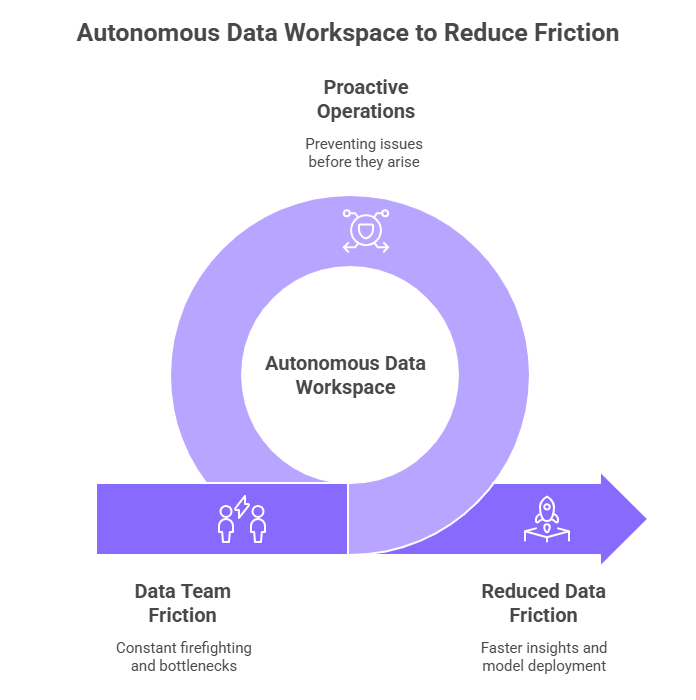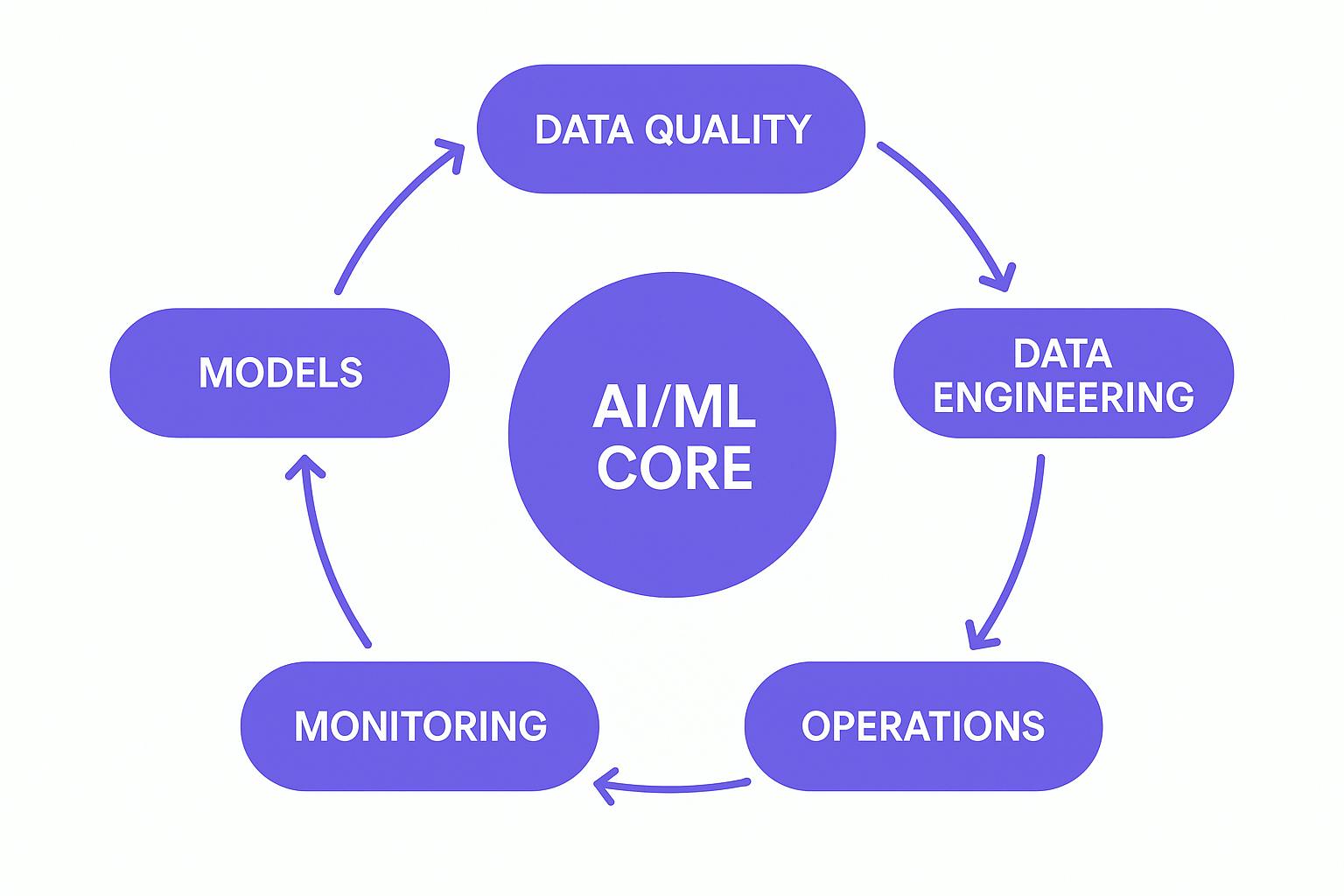Table of Contents
Loading table of contents...
What is an Autonomous Data Workspace and Why It Matters
- Data teams are overwhelmed by manual tasks and fragmented tools, despite advances in modern data stacks. The Autonomous Data Workspace (ADW) emerges as a transformative solution—an AI-driven, self-managing data ecosystem that automates ingestion, storage, governance, and MLOps. By reducing operational friction, it frees data professionals to focus on strategy and insight. ADWs improve data quality, speed-to-insight, governance, and cloud cost efficiency, making them essential for building agile, scalable, data-first organizations. This shift marks a move from "doing" analytics to "enabling" analytics at scale, positioning ADWs as the inevitable future of data infrastructure.
March 30, 2025

AB

The conversation around data is shifting. For years, we've focused on collecting more, building bigger lakes, and hiring brilliant minds to make sense of it all. Yet, many data professionals - confess (often in hushed tones) that their teams are still spending an inordinate amount of time on manual, repetitive tasks. The promise of data-driven agility feels perpetually just out of reach, bogged down by operational friction.
This isn't a people problem; it's a paradigm problem. The traditional, often fragmented approach to data tooling and workflows is straining under the weight of modern data demands.
This is where the Autonomous Data Workspace (ADW) enters the picture, not as another incremental improvement, but as a foundational evolution. An ADW isn't just a platform; it's an intelligent ecosystem designed to drastically reduce manual intervention and amplify human expertise across the entire analytics lifecycle. For leaders aiming to build truly data-first organizations, understanding the mechanics and implications of ADWs is becoming non-negotiable.
The Current Crossroads: Powerful Tools, Persistent Friction
Let's be honest. Even with sophisticated tools, the day-to-day reality for many data teams involves:
- Constant Firefighting: Managing complex pipelines, troubleshooting integrations, and ensuring data quality.
- Skill Bottlenecks: Heavy reliance on specialized engineers for tasks that should be simpler.
- Slow Time-to-Value: The journey from raw data to deployed model or critical business insight is often longer than we’d like.
- Integration Nightmares: Stitching together disparate tools for ingestion, storage, processing, analytics, and governance can feel like a never-ending puzzle.
- Reactive Operations: Addressing issues after they arise rather than proactively preventing them.
The modern data stack brought modularity, but it also brought complexity in orchestration and management. An Autonomous Data Workspace aims to transcend this.

Checkout: What is a Unified Data Platform and Why Do Businesses Need One?
Deconstructing the Autonomous Data Workspace: Beyond the Buzzwords
So, what truly constitutes an Autonomous Data Workspace? It's more than just a data warehouse with a few automation scripts. Think of it as a confluence of mature data management capabilities infused with layers of AI-driven intelligence. Here are the core pillars that define a true ADW:
Intelligent Data Ingestion & Continuous Validation:
- The Challenge: Data enters your organization from a myriad of sources, formats, and varying quality levels. Manually building and maintaining pipelines for each, plus ensuring data integrity, is a Sisyphean task.
- The ADW Approach: An ADW automates much of this. It can intelligently discover data schemas, adapt to changes in source structures, and apply AI-powered validation rules to identify anomalies, cleanse data, and flag quality issues proactively at the point of ingestion. This isn't just about scheduling ETL jobs; it's about adaptive, self-correcting data flows.
- Value: Reduces the engineering burden, ensures higher quality raw material for analytics, and accelerates data availability.
Self-Optimizing Data Storage & Processing:
- The Challenge: Ensuring queries run fast, storage costs are managed, and resources are allocated optimally often requires constant manual tuning by specialized DBAs or data engineers.
- The ADW Approach: The workspace continuously monitors workloads, query patterns, and data storage characteristics. Using AI, it can automatically index data, optimize query plans, manage resource allocation dynamically (e.g., scaling compute up or down), and even predict potential bottlenecks before they impact users.
- Value: Consistent performance, lower operational costs, and freeing up experts from performance firefighting. Imagine your data infrastructure tuning itself like a seasoned orchestra conductor, ensuring every instrument plays in perfect harmony without you lifting the baton for every note.
AI-Augmented Data Discovery & Semantic Cataloging:
- The Challenge: Data swamps are real. If analysts and scientists can't find the data they need, or don't understand its lineage, context, or quality, its value plummets.
- The ADW Approach: It automates the creation and maintenance of a rich, semantic data catalog. AI algorithms can profile data, suggest business terms, identify relationships between datasets, track lineage automatically, and even recommend relevant data to users based on their roles or past queries.
- Value: Drastically improves data discoverability, fosters trust in data, and accelerates the initial phases of any analytical project.
Embedded & Adaptive Governance and Security:
- The Challenge: Manually enforcing complex security policies, access controls, and compliance mandates (like GDPR, HIPAA, etc.) across a sprawling data estate is error-prone and a significant overhead.
- The ADW Approach: Governance isn't an afterthought; it's woven into the fabric of the workspace. Policies can be defined and automatically enforced. AI can help detect anomalous access patterns, flag potential security risks, and automate aspects of compliance reporting and data masking/anonymization based on sensitivity.
- Value: Reduced risk, improved compliance posture, and secure data democratization.
Integrated & Automated MLOps Capabilities:
- The Challenge: Getting a machine learning model from a data scientist's laptop into production and then reliably monitoring and retraining it is often a major hurdle (the "last mile" problem).
- The ADW Approach: Provides an integrated environment for the end-to-end MLOps lifecycle. This includes automated feature engineering suggestions, one-click model deployment, continuous model performance monitoring, drift detection, and automated retraining triggers.
Value: Accelerates the deployment of AI, ensures models remain accurate and relevant, and bridges the gap between data science and IT/operations.

Checkout: What is Generative BI and Why It Matters in 2025?
Why This Represents the Inevitable Future of Analytics
The move towards autonomous capabilities isn't driven by technological novelty; it's a pragmatic response to the escalating demands and complexities that data leaders face daily. Here’s a deeper look at why ADWs are becoming the new standard:
Transcending Human Scale for Data Operations: The sheer volume, velocity, and variety (the 3Vs, and now more) of data have outpaced human capacity for manual management. It's not about replacing humans, but augmenting them.
- Deeper Insight: Consider the cognitive load on a data engineering team managing hundreds of disparate data pipelines. Each pipeline has its own potential points of failure, performance quirks, and maintenance needs. An ADW doesn't just automate the scheduling; it automates the vigilance, the diagnostics, and often the remediation. This frees engineers to design more sophisticated data products, not just keep the lights on.
- Fact: The global autonomous data platform market was valued at USD 1.6 billion in 2023 and is projected to grow at a CAGR of 22.7% between 2024 and 2032, driven by the increasing adoption of AI and ML solutions in data management.
Elevating the Strategic Value of Data Teams: Your most valuable assets are your data scientists, analysts, and strategists. Their unique value lies in critical thinking, domain expertise, and interpreting complex patterns – not in data wrangling or pipeline debugging.
- Deeper Insight: An ADW acts as a highly efficient "research assistant" and "ops manager" for these experts. For example, an analyst doesn't have to spend 60% of their time finding and cleaning data (a commonly cited statistic); the ADW can present them with high-quality, cataloged data, allowing them to dive straight into exploratory analysis and insight generation. This is how you foster innovation and job satisfaction.
- Fact: Data professionals spend a significant portion of their time on data preparation and cleansing. The 2022 Anaconda State of Data Science report found that respondents spent approximately 37.75% of their time on these tasks. Other research suggests this figure can be as high as 45% to 80% depending on the project.
The Unrelenting Need for Business Agility & Speed-to-Insight: In a competitive market, the ability to quickly sense, interpret, and act on data-driven insights is a massive differentiator. Traditional analytics cycles, often measured in weeks or months, are too slow.
- Deeper Insight: ADWs compress this cycle by automating time-consuming stages. Imagine a marketing team wanting to analyze the impact of a new campaign. Instead of waiting days for data to be ingested, processed, and made available, an ADW could provide near real-time access to curated datasets, enabling faster campaign optimization and decision-making. The "time-to-query" and "time-to-model" are drastically reduced.
- Fact: Data silos, characterized by isolated data repositories and a lack of integration, severely hinder business agility, leading to inhibited collaboration, data inconsistencies, and impaired decision-making.
Democratization WITH Governance – Not a Contradiction: The goal of data democratization is to empower more users to leverage data. However, this often creates fears around data security, privacy, and misuse.
- Deeper Insight: ADWs address this by embedding governance within the democratizing tools. AI can help by suggesting appropriate access levels based on roles and project context, automatically masking sensitive PII based on user permissions, and providing clear lineage so users understand data provenance. This builds trust and allows for wider, yet safer, data access.
- Fact: Data governance continues to be a primary challenge for Chief Data Officers (CDOs), with 63% reporting it as the principal activity consuming their time in 2023, up from 44% in 2022. The shift is towards "data enablement," where governance acts as an enabler rather than a restrictive measure.
Economic Realities: Optimizing Cloud Spend & Resource Utilization: Cloud resources offer immense scalability, but without careful management, costs can spiral. Over-provisioning is common "just in case."
- Deeper Insight: The self-optimizing nature of ADWs directly impacts the bottom line. By dynamically scaling resources based on actual demand, optimizing storage tiers, and ensuring queries run efficiently, organizations can significantly reduce wasted cloud spend. AI can predict future load and pre-provision resources just-in-time, rather than just-in-case.
- Fact: Autonomous databases, like Oracle's, aim to reduce complexity and costs by automating manual administrative tasks such as provisioning, backups, and monitoring, and by optimizing for all workloads and data formats. They also allow for dynamic scaling of resources based on demand, leading to cost efficiency.

Checkout: What is an AI Data Engineer and How Do They Work?
The Shift from "Doing" Analytics to "Enabling" Analytics
For data professionals, the rise of the Autonomous Data Workspace signifies a shift in their own roles as well. The emphasis moves from directly "doing" many of the operational tasks to strategically "enabling" the organization with intelligent, self-service capabilities. It’s about designing the ecosystem, setting the guardrails, and empowering the rest of the business to innovate with data, confidently and efficiently.
This isn't a far-off vision; the foundational elements are here, and the trajectory is clear. Organizations that begin to strategically embrace and integrate autonomous capabilities into their data infrastructure will be the ones to lead in the coming years.
Recommended Blogs

10/17/2025

AB
How GFF 2025 Changes the Way BFSI Will Operate in India

10/13/2025

AB
Top 5 Ways to Improve Lending Operations for Business Growth
Actionable Operational Excellence
Autonmis helps modern teams own their entire operations and data workflow — fast, simple, and cost-effective.